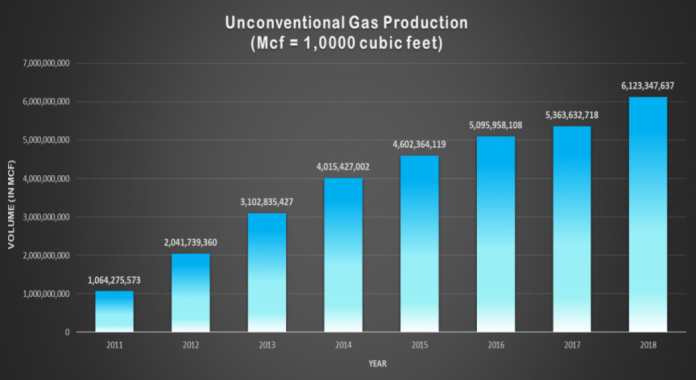
HARRISBURG, Pa. — Pennsylvania produced more natural gas last year than ever before, according to the 2018 Oil and Gas Annual Report released July 10 by the Pennsylvania Department of Environmental Protection.
Unconventional well operators produced 6.1 trillion cubic feet of natural gas, an increase of .8 trillion cubic feet over 2017. That’s the largest volume of natural gas produced in Pennsylvania in a single year.
The state is the second largest producer of natural gas in the country, next to Texas.
The department also reduced its permitting backlog by more than 90 percent since 2016 thanks to push to use more electronic tools, like online permitting.
Going electronic
The department launched an updated erosion and sediment control general permit in online and provided training to the industry on both the new requirements and the electronic application. This surface-activities permit is the second permit to go online, following the subsurface well-drilling e-permit, which rolled out in 2017.
Electronic permit applications eliminate manual data entry, ensure that applications are complete when submitted and enable operators to pay permit fees online, all of which make the process run more smoothly.
In addition, the department simplified its internal oil and gas permit review structure statewide, grouping personnel differently to enhance communication and teamwork.
Significant decreases
By the end of the year, average review time for the erosion and sediment control general permit dropped to 157 days in the southwest, down from about 230 days in 2016. The review time for the rest of the state is about 85 days, according to the report.
The average time to review well-drilling permit applications shortened to about 39 days statewide.
Across the department, the permit backlog has been reduced from more than 8,700 in early 2016 to just 635 in June.
Inspection efficiency also improved by about 20% through the use of portable tablets and other technological improvements. All inspections are now done electronically.
Department workers completed 36,873 compliance inspections at conventional and unconventional well sites last year, about 585 more than in 2017.
Permitting and drilling down
The department issued 1,868 unconventional well permits in 2018, about 160 fewer than the previous year. Sustained low commodity prices coupled with longer wellbores contributed to a decline in permit applications.
The number of unconventional wells drilled is also down to 777 from 810 the previous year. Of those 777 wells, 689 were drilled into Marcellus shale and 66 were drilled into Utica and Point Pleasant shale.
Much of the activity is focused in the southwest corner of the state, especially in Washington and Greene counties, according to the report.
Violations up
While the number of conventional well violations decreased this past year, unconventional well violations increased. Unconventional well violations went up from 821 in 2017 to 1,043 in 2018.
The department collected more than $4.1 million in fines and penalties related to non-compliance at oil and gas sites in the state, according to the report.
The full interactive report can be viewed online.











